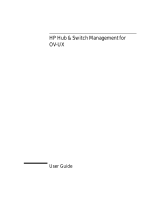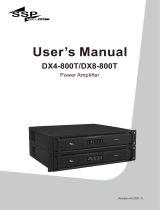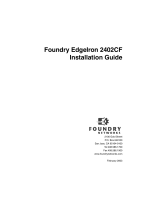Page is loading ...

Connectivity Quick Reference
for the HP AdvanceStack Switch 2000
100VG Connectivity
• Basic Configuration Guidelines:
The default Mode setting for the 100VG ports on the Switch 2000 and Switch-16 is
Auto Detect. When connecting these switches to other network devices, such as hubs
or other switches, the Auto Detect setting works in most cases and should be tried
before making any configuration changes. When connecting these switches to PCs and
workstations that have HP 10/100VG LAN Adapters, HP recommends setting the
Mode to Master.
Other allowable Mode settings are shown in the illustrations on the following pages
under “Port Mode”. The port Mode can be set through the Configuration menu using
the Switch 2000 console interface.
• Connections: 100VG ports on the Switch 2000 must not be connected to any 100VG
ports labeled “Uplink”. These ports are reserved for hub-to-hub connections.
Note that the illustrations show only twisted-pair connections; devices supporting
fiber-optic connections are connected similarly.
To connect to Set 100VG Port Mode to
Network device Auto Detect
PC or workstation Master
☞
☞
sd4pdf.fm5 Page 1 Thursday, February 20, 1997 4:31 PM

100VG Connectivity
2
Switch 2000 to 100VG Hub
Switch 2000 to PC
Use any Downlink port
Port Mode
Auto Detect
OR
End Node
Any End Node
(For Example, a
PC or Server)
sd4pdf.fm5 Page 2 Thursday, February 20, 1997 4:31 PM

100VG Connectivity
3
Switch 2000 to Switch 2000
Switch 2000 to Switch-16
Auto
Detect
Auto
Detect
Master
End
Node
Master
End
Node
OR OR
Port Modes
Auto
Detect
Auto
Detect
Master
End
Node
Master
End
Node
OR OR
Port Modes
sd4pdf.fm5 Page 3 Thursday, February 20, 1997 4:31 PM

100VG Connectivity
4
Switch 2000 to Switch 200
Switch 2000 to Router 650
Auto Detect
OR
End Node
Use Downlink Port
Port Mode
Auto Detect
OR
Master
sd4pdf.fm5 Page 4 Thursday, February 20, 1997 4:31 PM

UTP Ethernet/10Base-T Connectivity
5
UTP Ethernet/10Base-T Connectivity
Ethernet connectivity includes twisted pair (UTP) cabling (below), and fiber-optic cabling (page 9).
Twisted Pair Cabling
The Ethernet module for the Switch 2000 has 10Base-T ports that operate as MDI-X ports, and a slot to install a
10Base-T transceiver that operates as an MDI port.
• MDI-X Operation: The four 10Base-T ports built into the module are designed for MDI-X operation (that is, for
connecting end nodes to the switch). Thus, if you connect any of these ports to an MDI-X port on another device,
use a “crossover” cable. But if the connection is to an MDI port, use a “straight-through” cable.
• MDI Operation: An optional 10Base-T transceiver in the transceiver slot operates in MDI mode (that is, for con-
necting hubs or other switches to the Switch 2000). In this case, use a “straight-through” cable to connect the
transceiver to an MDI-X port on another device, or a “crossover cable” to connect the transceiver to another trans-
ceiver or other MDI port on another device.
Note that if the connection from the 10Base-T transceiver is to another HP 10Base-T transceiver (requiring a cross-
over cable), the “long cable” option can be set on both transceivers, allowing the connection to be up to 200 meters.
See the transceiver documentation for more information. (For more on straight-through and crossover cables, see
appendix A, “Cables and Connectors”, in the HP AdvanceStack Switch 2000 Installation Guide.)
Switch 2000 to AdvanceStack 10Base-T 48-Port Hub
Crossover Cable
sd4pdf.fm5 Page 5 Thursday, February 20, 1997 4:31 PM

UTP Ethernet/10Base-T Connectivity
6
Switch 2000 to PC
Switch 2000 to Switch 2000, Switch-16, or Switch 200
Any End Node
(For Example, a
PC or Server)
Straight-Through Cable
Note: This illustration also applies
when connecting a Switch 2000 to a
Switch-16 or a Switch 200.
Crossover Cable
sd4pdf.fm5 Page 6 Thursday, February 20, 1997 4:31 PM

UTP Ethernet/10Base-T Connectivity
7
Switch 2000 to Switch 208T
Switch 2000 to Switch 800T
Crossover Cable
Illustrates use of Switch 800T’s 10/100
capability for a 10 Mbit/connection.
Port Mode
Switch 2000: Half Duplex
Switch 800T: Auto Detect or 10/Half Dx
Switch 2000: Full Duplex
Switch 800T: Auto Detect or 10/Full Dx
Crossover Cable
sd4pdf.fm5 Page 7 Thursday, February 20, 1997 4:31 PM

UTP Ethernet/10Base-T Connectivity
8
Switch 2000 to Switch 200
Switch 2000 to Router 650
Crossover Cable
Note: As shown in this illustration,
a straight-through cable is used to
connect the Router 650 to a built-in
RJ-45 port in the Switch 2000 Ether-
net module. If the connection from
the Router 650 is to a 10Base-T
transceiver in the Switch 2000
Ethernet module, use a crossover
cable instead.
Straight-Through Cable
sd4pdf.fm5 Page 8 Saturday, February 22, 1997 12:00 PM

Fiber Optic 10Base-FL Connectivity
9
Fiber Optic 10Base-FL Connectivity
The 10Base-FL module for the Switch 2000 has four ports offering half-duplex or full-duplex operation. The module
supports the following fiber cable and connector types:
• 62.5/125 µm multimode graded-index fiber cable
• ST connectors
Switch 2000 to an AdvanceStack Hub
sd4pdf.fm5 Page 9 Thursday, February 20, 1997 4:31 PM

Fiber Optic 10Base-FL Connectivity
10
Switch 2000 to Another Switch 2000
Switch 2000 to a Switch-16
OR
sd4pdf.fm5 Page 10 Thursday, February 20, 1997 4:31 PM

Fiber Optic 10Base-FL Connectivity
11
Switch 2000 to a Router 650
sd4pdf.fm5 Page 11 Thursday, February 20, 1997 4:31 PM

100Base-T Connectivity
12
100Base-T Connectivity
The 100Base-T Module for the Switch 2000 enables up to two ports offering half-duplex or full-duplex operation
with options for either twisted-pair (UTP) cabling (below) or fiber-optic cabling (page 16).
Note: The 100Base-T Module can also be configured for 10Mbit/s operation using the HP J3192A/B 100Base-TX
Twisted-Pair Transceiver Module. Cabling is done in the same way as shown in the “Twisted Pair Cabling” section
that begins on page 5. A “Caution” similar to the one below applies to such connections.
Caution: For any connection between a pair of 100Base-T ports, ensure that both ports are configured the
same. For example, network speed and the transfer mode (full- or half-duplex) should be the same for both
ports. If Auto Negotiation is used between the ports, both ports must comply with the IEEE 802.3u “Auto-
Negotiation” standard. Configuration differences or use of devices that are not standards-compliant could
result in significant network errors. For more information, refer to the online Help included in the Switch 2000
console interface.
UTP 100Base-T Cabling
The 100Base-T Module for the Switch 2000 has two slots for installing HP J3192A/B 100Base-TX Twisted-Pair
Transceiver Modules. These transceivers require category 5 UTP cable and offer half-duplex or full-duplex operation
at either 10 Mbit/s or 100 Mbit/s speeds. (Refer to the manual provided with the transceiver.)
Switch 2000 to Switch 100
Crossover Cable
sd4pdf.fm5 Page 12 Thursday, February 20, 1997 4:31 PM

100Base-T Connectivity
13
Switch 2000 to Switch 16
Switch 2000 to Switch 208T or 204
Crossover Cable
Crossover Cable
sd4pdf.fm5 Page 13 Saturday, February 22, 1997 12:02 PM

100Base-T Connectivity
14
Switch 2000 to Switch 800T
Switch 2000 to a Server or a PC Workstation
Crossover Cable
Straight-Through Cables
sd4pdf.fm5 Page 14 Thursday, February 20, 1997 4:31 PM

100Base-T Connectivity
15
Switch 2000 to Another Switch 2000
Switch 2000 to an AdvanceStack 100Base-T Hub
Crossover Cable
Crossover CableStraight-Through Cable
MDI Port
MDI-X Port
OR
sd4pdf.fm5 Page 15 Thursday, February 20, 1997 4:31 PM

100Base-T Connectivity
16
Fiber-Optic 100Base-T Connectivity
Switch 2000 to Switch 800T
Switch 2000 to Switch 208T
sd4pdf.fm5 Page 16 Thursday, February 20, 1997 4:31 PM

100Base-T Connectivity
17
Switch 2000 to Switch 2000
sd4pdf.fm5 Page 17 Thursday, February 20, 1997 4:31 PM

FDDI Connectivity
18
FDDI Connectivity
The FDDI Module for the Switch 2000 uses a dual-port FDDI interface, with two FSD (fixed shroud duplex) connec-
tors labeled MIC A and MIC B (media interface connector).
• Either MIC A or MIC B is used to attach the switch to a single attach station (SAS).
• Both MIC A and MIC B are used in one of the following ways:
• To attach the switch as a dual attach station (DAS)
• To attach the switch to two single attach stations
• To set up the switch as a dual-homed device
You can also use an optical bypass switch to prevent the FDDI ring from “wrapping” if the switch connected as a
DAS loses power or if the FDDI port becomes available. For more information on this topic, refer to the installation
guide provided for the FDDI Module.
Example of the Switch 2000 as a Dual-Attachment Station (DAS)
Adjacent DAS
B
A
A
Adjacent DASAdjacent DAS
sd4pdf.fm5 Page 18 Thursday, February 20, 1997 4:31 PM

FDDI Connectivity
19
Example of the Switch 2000 as a Single-Attachment Station (SAS)
Example of the Switch 2000 as a Dual-Homed Station
FDDI Concentrator
(shown as a dual-attach
device)
Connect Either MIC A or MIC B to
any M Port on a Concentrator
M
M
M
M
B
A
Primary FDDI Concentrator
Secondary FDDI Concentrator
Connect MIC A and MIC B to any M
Port on Separate Concentrators
M
M
M
M
B
A
MM
M
A
M
B
Note: The connection to the
secondary concentrator operates
only if the connection to the primary
concentrator becomes disabled.
sd4pdf.fm5 Page 19 Thursday, February 20, 1997 4:31 PM

FDDI Connectivity
20
Example of FDDI Standalone Networking with Two SAS Connections
PC Server
Unix NFS Server
sd4pdf.fm5 Page 20 Thursday, February 20, 1997 4:31 PM
/



